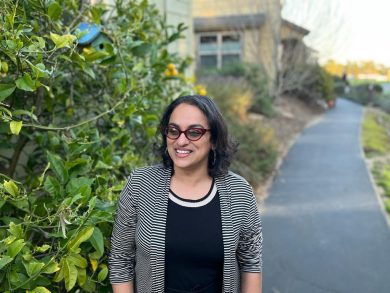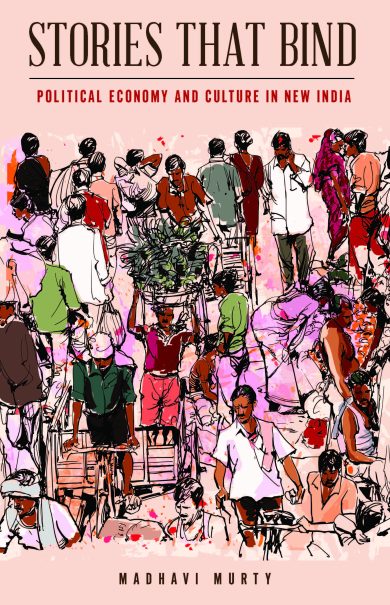 Dr. Madhavi Murty is an Associate Professor in the Feminist Studies Department at UC Santa Cruz. She is a THI Faculty Research Fellow for 2022-2023, and currently serves on THI’s Steering Committee. Dr. Murty is working on a book project titled Sonic India, which explores how sound–soundscapes, voice, music, noise– is entangled with nationalisms and capital in India. In January, we discussed Dr. Murty’s approach to ‘the people’ as a sonically constituted category, and reflected on the importance of interdisciplinary collaboration and funding in the humanities.
Dr. Madhavi Murty is an Associate Professor in the Feminist Studies Department at UC Santa Cruz. She is a THI Faculty Research Fellow for 2022-2023, and currently serves on THI’s Steering Committee. Dr. Murty is working on a book project titled Sonic India, which explores how sound–soundscapes, voice, music, noise– is entangled with nationalisms and capital in India. In January, we discussed Dr. Murty’s approach to ‘the people’ as a sonically constituted category, and reflected on the importance of interdisciplinary collaboration and funding in the humanities.
Hello Professor Murty! Thanks for chatting with us about your research and all the wonderful humanities work you’ve been involved in. Congratulations again on being named a 2022-2023 THI Faculty Research Fellow! To begin, could you give us a brief synopsis of your second book project, Sonic India: Sound and the Making of Folk Nationalisms?
Thank you so much for this opportunity to share a little bit about my work. I am in the very preliminary stages of conceptualizing my second book project that I have tentatively named, Sonic India. The last chapter of my first book, Stories that Bind: Political Economy and Culture in New India, focused on the cinematic rendering of love and its entanglement with Hindutva neoliberalism (the Indian iteration of the product of authoritarian nationalism and neoliberalism). One section in that last chapter explored the love song in Hindi language cinema and argued that it was an unruly audio-visual presence within this entanglement. Sonic India takes off from here. It extends my interest in political economy, nationalisms and popular culture and is invested in analyzing the relationship of sound with nationalisms but also with capital. Journeying through three temporal nodes, diverse iterations of nationness, political economic formations and media and sound technologies – 1930-1960, 1970-2000 and lastly, 2000-2020 – it asks what we would learn about nationalism’s entanglement with capitalism if we listened to the shifting soundscapes that served to define a people as a nation at different moments in time? I am interested in analyzing how the category ‘people’ is constituted sonically. Assuming that sonic and melodic constructions are significant to the mobilization of people as ‘the people,’ my aim is to investigate the specific semiotic and cultural labor that is performed by sound during such mobilizations. My working hypothesis, which draws on the analysis of the love song in my first book, is that there is an openness to sonic and musical constructions that are ideologically closed by visual and textual sign systems and it is this relationship of unstable dominance that I want to examine centrally in the second project.
You have said about Sonic India that the project aims to track “lines of continuity and dissonance in the construction of the ‘people’ as a sonic category.” Can you say more about this “sonic” construction? How does centering sound and music change the way we historicize nationalism?

Dr. Murty’s first book, Stories that Bind: Political Economy and Culture in New India, was published in 2022 by Rutgers University Press
Analyses of nationalisms even as they have emphasized affect and the senses, particularly after the significant interventions of Benedict Anderson, have centered print-capitalism and therefore the modern forms of the newspaper, the novel and the periodical. The primacy of the eye as the most significant sense organ has been an assumption undergirding this work. In the context of South Asian studies, where my work is located, it has been noted that visual and textual sources are typically privileged; this has been particularly true for analyses of nationalisms. And yet, sound, soundscapes, music, even noise are imperative to the production and reproduction of the structure of feeling that is constitutive of nationalisms and capitalism. In centering sound and the technologies that enabled its recording, gave it form and circulated it, I am hopeful that we can hear and tell an even more layered story about nationness. The ‘nation’ often appears as the form through which collectives and collectivity get defined as if Anderson’s position about the nation form becoming modular and traveling was not an argument but an aphorism. My hope in thinking historically about the category “folk” and “people” through listening to sound, voice, music and noise is that we learn more about the diverse ways in which these categories were (and are) being constituted, the multiple ways in which collectivities are voiced but also stabilized through the concept of the nation. So, my aim with this project is not just to focus analytical attention on an archive that has had scant attention but more significantly, to study how the ‘sound of the people’ or folk is conceived as a soundscape without assuming the stability of the sound or melodic category folk. I aim to track how the category “people” is constituted sonically in Indian public culture across the three temporal nodes that I am interested in as well as the processes through which that complex soundscape is stabilized into the dominant concept of the nation.
You’ve participated in a number of Research Clusters in The Humanities Institute including “Border Regimes and Resistance in Global Perspective,” “Feminist Futures in the Indian Ocean,” and “Vernaculars of Travel in South Asia and the Middle East.” Why is it important for you to engage in this kind of interdisciplinary research collaboration? Could you share one discovery you made or perhaps an event you participated in during your time working in these clusters that felt particularly special to you?
I think the research clusters in The Humanities Institute enable the kind of interdisciplinary conversations that are essential for a thriving intellectual community.
I think the research clusters in The Humanities Institute enable the kind of interdisciplinary conversations that are essential for a thriving intellectual community; they bring together conversations around a concept or a set of questions from divergent perspectives that have the potential of invigorating different fields. The Vernaculars of Travel research cluster, led by Nidhi Mahajan and Muriam Davis, organized a discussion of my book recently, where Radhika Prasad, doctoral candidate in Literature was the discussant. In addition to the conversation with Radhika, who raised an important set of questions, I learned a great deal from the interdisciplinary group of scholars in the audience who were all brought together by the research cluster. My work often does not sit squarely within distinctly defined disciplinary bounds and it is in such interdisciplinary spaces as those brought together by the research clusters as well as the Cultural Studies colloquia that I feel most at home.
As part of your role as a member of THI’s Steering Committee, you review applications for THI fellowships. What has been your experience learning about the humanities projects happening on campus? Why is this funding so important for humanities scholars?
I have enjoyed reading and learning about the humanities projects on campus. Reading about the kind of public humanities projects some of our colleagues are working on was particularly exciting, this is analytically rigorous, impactful work addressing questions of significance for our time. Funding for humanities scholars is sparse, often restricted by various conditions and limited and yet the work takes on the gargantuan task of thinking about how our worlds have been organized and how we make sense of ourselves within them. Funding not only enables this scholarship through ensuring the availability of time and some resources but also acts as recognition for this work.
I wonder if you have any advice for humanities students applying to fellowships?
The range of work – from historical research, literary analysis, feminist media studies, poetry and other artistic productions – undertaken by our students is inspiring.
I have been so impressed with some of the work students in the humanities are engaged with. In addition to serving on the THI Steering Committee this year, I have also served on the Dean’s and Chancellor’s awards committee in the Humanities division along with other undergraduate studies directors from different departments. The range of work – from historical research, literary analysis, feminist media studies, poetry and other artistic productions – undertaken by our students is inspiring. I would encourage students in the Humanities to apply to as many relevant fellowships and funding opportunities that are available to them. They should make looking at fellowship calls and writing applications a mundane (as opposed to an exceptional) task. I would also encourage them to have good, sustained conversations with the mentors who are writing their recommendation letters. Such conversations are beneficial for letter writers in producing a letter that best describes the students’ contributions and enables the student to hone and polish their application materials.